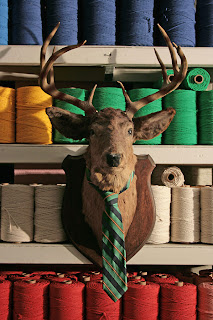Balmorality: Abstract noun; an enthusiasm for a stereotyped Scottish aesthetic.
I was prompted to do this post after being given several well chosen gifts from my mother for the Balmoral / Billiard room at Willowbrook - A large set of pewter deer antlers, a pair of pewter stag book ends, and a pewter sculpture of a stag and a doe.
They reminded me of a documentary I had seen about Balmoral Castle, and the Victorian aesthetic movement known as Balmorality. Victoria and Albert were enamoured with a very romantic ideal of Scotland, the sort portrayed by the Scottish poets and novelists, such as Sir Walter Scot. They made their castle a concentrated pastiche of this stereotyped 'scottishness'.
Photo: Stuart Yeates
Above and Below: Balmoral Castle
Balmoral Castle was first leased by Prince Albert in 1848 and subsequently purchased in November 1851. The 15th-century house was soon regarded as inadequate and was replaced by an entirely new, larger building. Prince Albert helped with the design, and Queen Victoria wrote proudly, ‘all has become my dearest Albert’s own creation, own work, own building, own laying out’.
The interiors of Balmoral were given a strong Scottish flavour. The carpets, curtains and upholstery were in a range of tartans, including ‘Hunting Stuart’ and ‘Balmoral’, designed by Queen Victoria and Prince Albert. Wallpaper incorporated patterns of thistle and heather, and the walls were hung with drawings by Edwin Landseer and prints of his paintings, mostly Highland scenes. In the Drawing Room there was a remarkable set of 12 candelabra in the form of Highlander figures holding deerstalking trophies, a collaboration between two British manufacturers, Minton and Winfield. Furniture was made by the London firm of Holland & Sons to simple but high-quality designs, mostly in light woods, such as satin birch or pine. Pieces for the most important rooms were embellished with silvered mounts, decorated with the royal couple’s ciphers or Scottish symbols.
Every year the Queen and the Prince travelled north for their autumn Highland holiday, enjoying the home of their own making and the freedom they found there. Prince Albert made his final visit to Balmoral in 1861, just months before he died. The Queen continued the tradition of the annual Highland stay following Prince Albert’s death, making her last visit to the Castle in 1900.
Stag heads and tartan abounded. Unsurprisingly, this style has continued to be popular periodically, with ever changing contemporary twists.
Taxidermy in general has a sort of Baronial style about it, though not always tasteful...
I very much like the stag wallpaper. No animals harmed in the making thereof...
Tartan of course figures heavily in the Balmorality movement. Tartan was briefly outlawed with the 1746 Dress Act after the Jacobite Rebellions (with the exception of the black watch Regiment).


Photo: eclecticrevisited.com
Photo: interior-freedom.blogspot.com
Photo: Alkemie.blogspot.com

Here is the vintage documentary about Balmoral, including a good explanation of Balmorality...
For those interested in tartan decor and scottish themed style, you might like to check out Tartanscot's blog.
For those interested in Taxidermy, see our previous posting.

















No comments:
Post a Comment